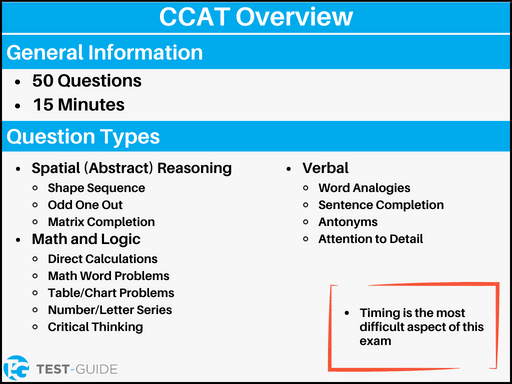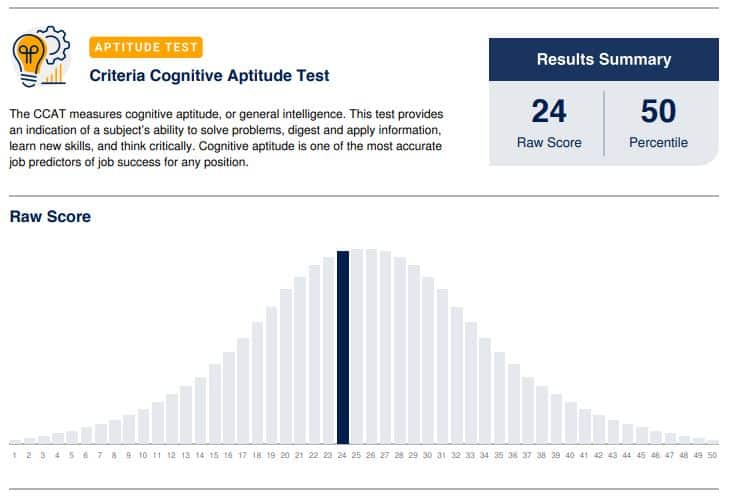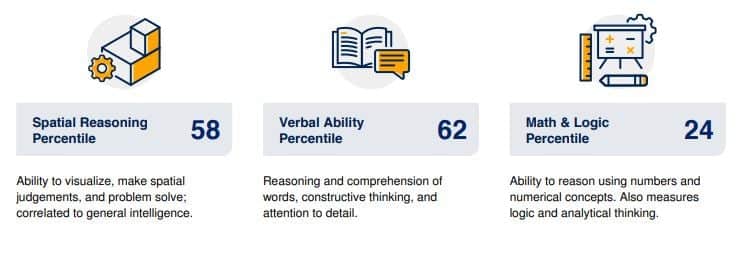What is the CCAT?
The CCAT (Criteria Cognitive Aptitude Test) is an exam used to predict your performance on a job by measuring your cognitive ability. It is one of the most popular cognitive assessment tests given. Employers will give this exam to potential candidates to measure their ability to solve problems and think critically.
There are 50 total questions on the CCAT with a time limit of 15 minutes. The exam is split into 3 different kinds of questions:
- Verbal
- Math
- Spatial Reasoning
The CCAT is administered by Criteria Corp and can be used for a wide variety of jobs.
The CCAT is very similar to the Wonderlic – both exams have a similar number of questions, question types, and are used during the hiring process.
You can use our Wonderlic assessment to prepare for that exam.
CCAT Outline
The CCAT test has 50 total questions and 15 minutes to complete it. The questions will be 3 types:
- Verbal
- Math
- Spatial Reasoning

Spatial (Abstract) Reasoning
These questions assess your ability to reason using fluid information such as abstract shapes and figures to arrive at conclusions based on just a few examples. You will need to evaluate the shape and structure of each figure, mentally rotate the shape, and find the missing element.
Spatial reasoning questions show how well you can learn and make use of new information to solve problems.
- Shape Sequence: Will be shown a series of 3-5 elements, representing a meaningful sequence. You must identify the next element in the series.
- Odd One Out: You will be shown five elements; each element may either be a single shape or several shapes assembled. Your goal is to identify the item with one feature that can distinguish it from the rest of the elements and mark it.
- Matrix Completion: You will be shown a 3-by-3 matrix of figural elements. One of the elements will be missing, and you need to find the missing element within the answers.
Math and Logic
These questions are not an assessment of your basic math skills. It is a test of your ability to quickly work with numerical and logical information to find a solution for a problem, which directly relates to your ability to think critically and solve problems in the real world.
You can use a pencil and paper when working out the answers, but calculators are not allowed. Some types of problems you will see include:
- Direct Calculations: These are straightforward basic math questions.
- Math Word Problems: You are asked to read the question, translate it into a mathematical problem, and solve the problem.
- Table/Chart Problems: You are asked to examine information in the form of a table or a chart and solve a mathematical problem.
- Number/Letter Series: You are shown a sequence of numbers or a sequence of batches of letters. Your goal is to determine which option is the next number, letter, or batch of numbers or letters in the series.
- Critical Thinking: These questions assess your ability to critically evaluate syllogisms and decide whether they are true or false.
Verbal
These types of questions are not an assessment of your reading and writing proficiency. They are a test of your vocabulary level, which reflects your general education level and your ability to communicate clearly.
The verbal test section has four types of questions:
- Word Analogies: You are shown a pair of words B. Your goal is to identify the relationship between the words and find the pair of answers that contain the same relationship as the original pair.
- Sentence Completion: You are shown a sentence that includes one or two words missing. You are asked to complete the sentence with the correct word/s.
- Antonyms: You look for the word that is most nearly the opposite of a given word.
- Attention to Detail: You are shown several pairs of names, addresses, companies, etc. You are asked to count how many pairs are identical and how many are different.
Studying for the CCAT
The CCAT is a high stakes exam for many individuals. This exam is very important as it is given during the hiring process. You will want to score well to ensure you get the job.
Here are some tips you can use when studying for the CCAT:
- Develop Some Time-Saving Methods to Complete the Entire Exam
- None of the CCAT questions are complicated, but answering 50 questions in 15 minutes can be extremely difficult and stressful.
- While you are taking a CCAT practice test do not be afraid to re-examine the questions and ask yourself how you could answer them a bit faster.
- Focus On Your Strengths and Learn to Earn Points Easily
- A passing score of 28 is necessary for most positions. To be a top-tier candidate you will need a passing score of at least 32 for most jobs. It is essential to get the correct answer on as many questions as possible within the allotted exam time.
- Focus on questions that are easier to answer quickly and correctly and let go of items requiring greater and longer attention. A free CCAT practice test will help you discover which sections you struggle with the most.
- Take a Break Between Exam Preparation Sessions Before Approaching Your Real Test
- If you take a significant break between CCAT preparation, in which you rest and refresh yourself, you can get back and continue to improve in the next preparation session. Take some time, let everything sink in, take a revitalizing break, and only then approach the test.
- Learn What Is Required of You In Each Type of Question
- The instructions you get in the CCAT may sometimes be a bit confusing or unclear. One of your critical goals during preparation should be to understand what is required of you in each type of question. This is why CCAT practice is important as it will help you become more familiar with the actual exam.
- Prepare Under “Real Test” Conditions
- Use a full-length CCAT practice test and apply all the test limitations. This process will make many stress-inducing elements of the test much less intimidating.
- Consider Investing In Professional CCAT Preparation
- If scoring high on the CCAT is important to you, you should invest in a professional prep course
- BoostPrep is our recommended provider.
CCAT Administration
The CCAT is part of Criteria Corp’s HireSelect platform for employers. Employers administer the test to prospective employees via computer.
The CCAT is usually taken at home and is not proctored. However, some employers may ask you to take the exam again to verify your score. This 2nd exam may require a proctor.
CCAT Requirements
The CCAT is administered only to prospective employees at organizations that have purchased the HireSelect platform from Criteria Corp. After you take the Criteria Cognitive Aptitude Test, your exam results and profile report can be accessed immediately by the company you applied to.
Your exam results will be compared to the HireSelect database, and to the results of the other candidates applying for the position you are after.
This information gives the recruiter the information they need to determine which profile best matches the job position for which they are hiring.
CCAT Scores
The first page of your score report shows your raw score and percentile ranking.
- Raw Score: Number of questions you answered correctly.
- Percentile Score: Comparison of your score to other test-takers. If you score in the 60th percentile, you scored 60% better than others.

Source: Criteria Corp
The CCAT passing score depends on the position to which you apply. The CCAT average score is 24 correct questions out of 50, and less than 10% of people answer more than 35 questions correctly. Answering 42 questions correctly will put you on the top scale for ANY job the CCAT tests.
For higher paying jobs such as software engineering, banking, and management, one should strive to correctly answer 30 questions to be considered a top candidate.
When Do You Receive CCAT Scores?
CCAT scores are calculated immediately and your prospective employer will receive a detailed report within moments of you completing the test.
It is important to note that most employers do not share the test results with the candidate. You may just receive a pass or fail message instead of the full score report.
Sub-Scores
Your prospective employer also receives separate scores for each of the three sections. The scores obtained in these three categories are percentiles. If you scored a 24 in math and logic, 62 in verbal, and 58 in spatial reasoning:
- You scored better than 24% of other test-takers in math and logic.
- You scored better than 62% of other test-takers in verbal.
- You scored better than 58% of other test-takers in spatial reasoning.

A sample score report from Criterion can be viewed here.
Suggested CCAT Scores By Position
| Position | Low Score | High Score |
|---|---|---|
| Accounting/Finance | 24 | 39 |
| Administrative Assistant | 20 | 39 |
| Analyst | 26 | 42 |
| Bookkeeper | 20 | 35 |
| Computer Programmer | 23 | 40 |
| Controller | 24 | 39 |
| Customer Service Representative | 18 | 32 |
| Finance Manager | 21 | 40 |
| Financial Analyst | 23 | 38 |
| Front Desk/Reception | 18 | 30 |
| Lawyer/Attorney | 29 | 42 |
| Loan Officer | 24 | 38 |
| Network Administrator | 23 | 37 |
| Operations Manager | 22 | 40 |
| Product Manager | 26 | 41 |
| Production Manager | 18 | 34 |
| Project Manager | 22 | 37 |
| Recruiter | 21 | 35 |
| Sales Manager | 23 | 37 |
| Sales Representative | 21 | 35 |
| Sr. Manager/VP | 29 | 42 |
| Store Manager | 20 | 37 |
Source: Criteria Corp
Frequently Asked Questions
Is the Criteria Cognitive Aptitude Test an IQ test?
No, the CCAT is not a test of IQ. An IQ test measures intelligence, while the CCAT measures the skills that employees will need to perform on the job.
You can use our IQ test to prepare for that exam if you wish.
What employers use the CCAT in the hiring process?
Criteria Corp does not give out a specific list of companies who use the CCAT, but some known employers include:
- Vista Equity
- Tibco
- Marketo
- Solera
- Infoblox
- Cvent
- Mindbody
- Apptio
- PowerSchool
- Crossover
What is a good score on a CCAT?
A passing score of 28 is necessary for most positions. If you want to be considered a top candidate, you should shoot for a score of 32 or higher.
Is the CCAT test hard?
The actual questions on the CCAT are not the most difficult. What is difficult about the CCAT is the timing aspect. You will need to answer 50 questions in a 15-minute timespan.
Many individuals struggle with the time limit. This is what makes using a CCAT practice test so important.
How can I prepare for CCAT?
Some of the best methods to prepare for this exam include taking a CCAT test beforehand and trying to find where you struggled the most. Once you find the areas you struggled in, you can find ways to solve those questions in a quicker manner.
CCAT test prep is a great option as well. There are many options available but BoostPrpe is our recommended provider.
What is the average score on the CCAT?
The average score on the CCAT is 24 out of 50. If you score a 24, you will be in the 50th percentile of candidates who have taken this test.

